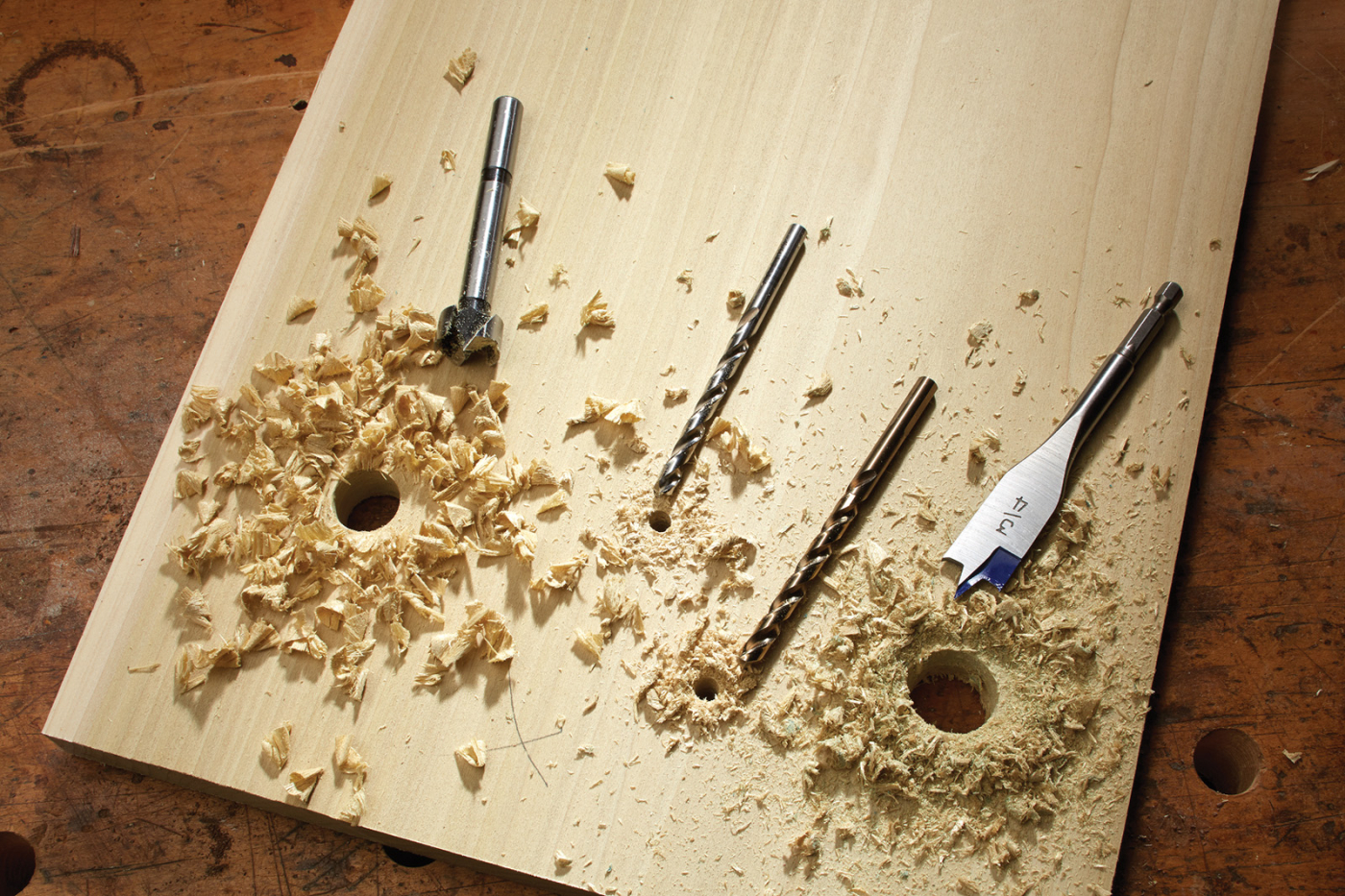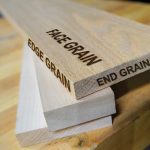We may receive a commission when you use our affiliate links. However, this does not impact our recommendations.

Pick your bit. All of these bits can drill holes in wood – so which should you choose? From left are pictured a Forstner bit, twist bit, brad-point bit and spade bit.
Discover a bit about clean, accurate boring.
There are many tools in modern woodworking you can use to bore holes: powered drills (both corded and cordless), drill presses, hand-powered eggbeater drills, braces and more.
Drill presses are the powered method of choice when accuracy is important. Battery-operated drills are convenient and fast. Corded drills are fast, never need charging and are usually lighter in weight than their battery-powered brethren. Eggbeater drills are awesome when you need just a few holes. Braces are ideal for drilling large-diameter holes with ease, and making holes at odd angles (as in chairmaking) without a lot of crazy jiggery.
It’s Basics Week 2024! Use the code Basics25 to save 25% off your first month or full year of PopWood+.
Auger Bits

Two common patterns. The Irwin-pattern bit (top) has more widely spaced flutes than the Jennings-pattern bit. Note, too, the difference in the lead screws. The coarse lead screw on this Irwin is for softwood; the fine thread on this Jennings is for hardwood.
Auger bits are used in a brace and come in two common patterns: Irwin (top) and Jennings. Both have self-feeding lead screws to help locate the cut and drill a lead hole; lead screws on both come in three iterations: fine (hardwoods), medium (hard and softwoods) and coarse (softwoods). Both patterns have two sharp spurs to score the circumference and two cutting lips to bore the hole. Unlike the Jennings, the Irwin has a solid central shaft; for every three spirals in the cut for the Jennings there are two spirals for the Irwin. The latter is less likely to clog when boring deep holes – but due to its wider spiral spacing, it’s more likely the beginning borer will ream a hole while cutting. Like all bits, augers must be kept sharp and rust-free to work well. They are typically available in 1⁄4“-1” diameter.
Twist Bits

 These bits are designed to cut metal, but are commonly and successfully used on wood, too. It can be tricky to get a twist bit started in a precise location and it may follow the grain in the cut. To combat that, use an awl or other pointy tool to start a hole exactly where desired. Twist bits can cause splintering, particularly on the backside of work.
These bits are designed to cut metal, but are commonly and successfully used on wood, too. It can be tricky to get a twist bit started in a precise location and it may follow the grain in the cut. To combat that, use an awl or other pointy tool to start a hole exactly where desired. Twist bits can cause splintering, particularly on the backside of work.
■ Common sizes: 1⁄32“- 5⁄8“
Brad Point Bits

 These are the best choice for most small-diameter holes in woodworking. The brad point allows you to locate the bit precisely, and keeps it from wandering. The spurs at the tip cut a cleaner hole and reduce splintering both on the entry and backside. (Also, bit sizes up to about 1⁄4” can be use with eggbeater drills).
These are the best choice for most small-diameter holes in woodworking. The brad point allows you to locate the bit precisely, and keeps it from wandering. The spurs at the tip cut a cleaner hole and reduce splintering both on the entry and backside. (Also, bit sizes up to about 1⁄4” can be use with eggbeater drills).
■ Common sizes: 1⁄16“- 5⁄8“
Spade Bits

 These bits are best for hogging out waste quickly when a clean hole is not an issue; they usually cause bad splintering, particularly on the backside of a workpiece (and some splintering on the front) – though scribing the cut first in reverse alleviates this to some degree. Inexpensive spade bits can be easily ground for custom sizes.
These bits are best for hogging out waste quickly when a clean hole is not an issue; they usually cause bad splintering, particularly on the backside of a workpiece (and some splintering on the front) – though scribing the cut first in reverse alleviates this to some degree. Inexpensive spade bits can be easily ground for custom sizes.
■ Common sizes: 1⁄4“- 1-1⁄2“
Forstner Bits

 These bits cut clean, accurate flat-bottomed holes in larger diameters. The lipped edges shear material to cleanly define a hole’s edge and the center point makes it simple to locate the hole’s center. Due to the force needed to make the cut, Forstner bits are best used in a drill press or brace.
These bits cut clean, accurate flat-bottomed holes in larger diameters. The lipped edges shear material to cleanly define a hole’s edge and the center point makes it simple to locate the hole’s center. Due to the force needed to make the cut, Forstner bits are best used in a drill press or brace.
■ Common sizes: 5⁄16“- 2”
Level & Plumb
A drill press excels at boring accurate holes at a predetermined angle – but so can you; it just takes a little practice. I assume the majority of beginning woodworkers use an electric drill – so let’s consider the proper grip.
Like a handsaw or handplane, a drill is best used with a three-fingered grip. Use your middle finger to depress the trigger; your index finger should point along the side of the tool, in the direction that you are drilling. Your pointing finger helps to cue your body to head in the same direction. I realize it sounds a little bit nutty – but try it out; you’ll discover it works for just about any tool that you grip with one hand.
It’s also important to realize that for many holes, there is a critical and non-critical axis, and to align your tool and body on the critical axis.
Let’s use clearing waste from a mortise as an example. Looking from the end of the workpiece, what’s important is that you don’t let the bit list side to side; front to back is OK (except at the ends). Thus, side to side is the “critical axis.”
Sight your bit against a try square centered at the far end of the mortise (or draw a centerline beyond the end of the mortise to guide you), and align your body in front that guide. The try square or line, along with your body position, will help you keep the tool in the critical axis.
Cut a Clean Hole
If you need a hole in a show surface and are worried about splintering, back up the cut with a piece of scrap (you can also apply a piece of painter’s tape atop the hole location before deploying the drill, which is moderately effective). Better yet, scribe the cut first by slowly moving the bit in reverse by hand – or, if at the drill press, by lowering the bit onto the wood then rotating the workpiece.
Pilot Hole vs. Clearance Hole
You’ve no-doubt seen the instruction to “drill a pilot hole.” That’s simply a small hole centered in the cut to help lead the way for what comes next – a larger-diameter hole, a nail or a screw. A pilot hole is tight enough that the next bit (or hardware) cuts into the hole’s walls.
A clearance hole, however, clears a wide path for what follows, such as a bolt, or a screw through the top of two boards being joined together.
Conclusion
This is obviously not the whole story on bits and boring – but I hope it’s enough to get you started on the path to drilling success.
Here are some supplies and tools we find essential in our everyday work around the shop. We may receive a commission from sales referred by our links; however, we have carefully selected these products for their usefulness and quality.








